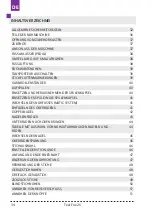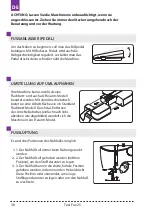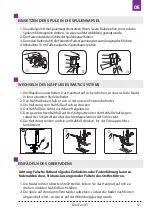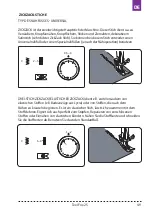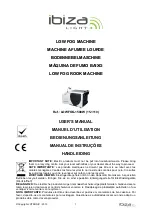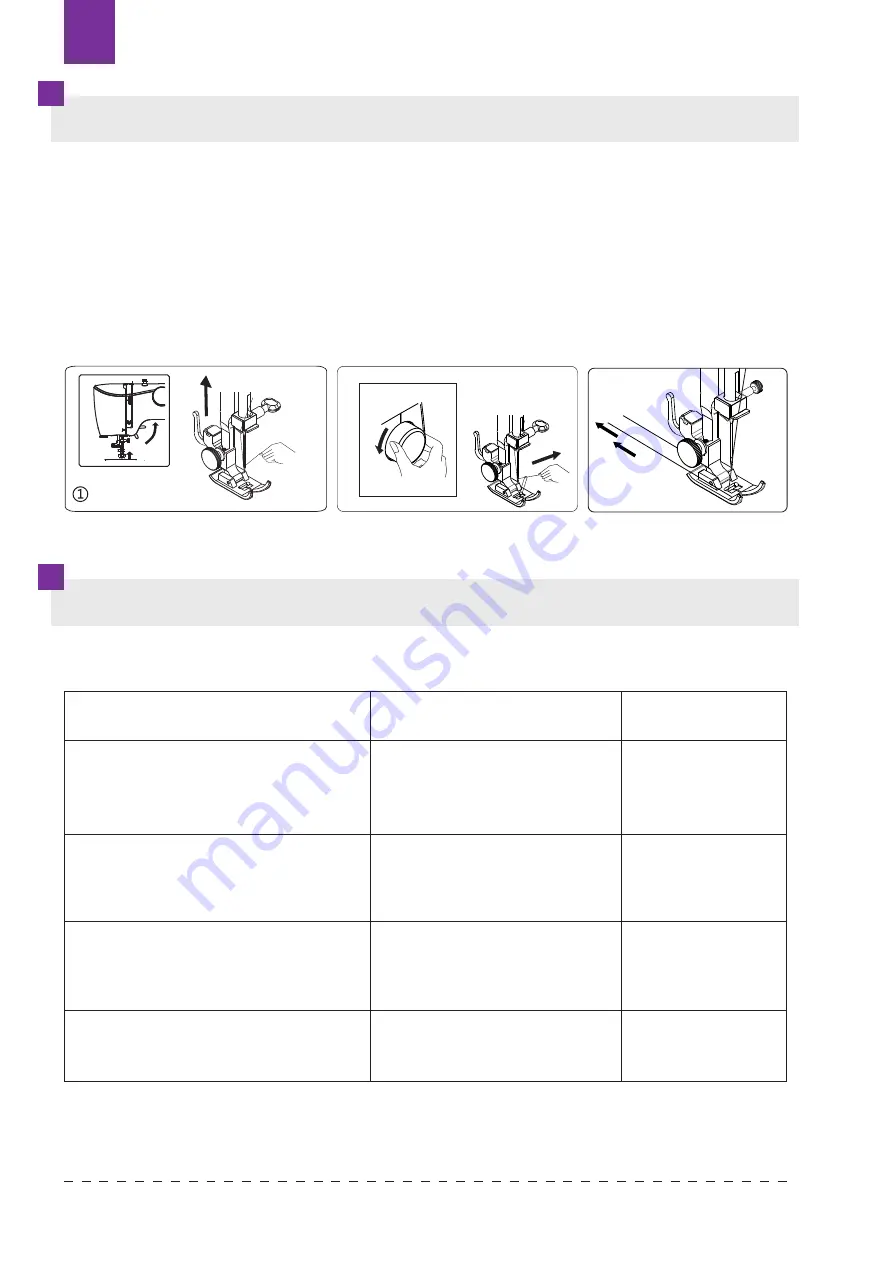
DE
UNTERFADEN NACH OBEN BRINGEN
TABELLE MIT AUSWAHL VON NÄHGUTABHÄNGIGEN NADELN UND FÄDEN
1.
Den Nähfuß heben
2.
Halten Sie leicht den Faden an der Nadel und drehen das Antriebsrad oder
betätigen Sie zweimal die Taste der Nadelpositionierung. In dem Fall macht das
Antriebsrad eine Drehung.
3.
Den Oberfaden aus der Nadel herausnehmen. Der Unterfaden wird über die
Stichplatte herausgenommen. Den Oberfaden leicht ziehen, gleichzeitig wird der
Unterfaden herausgenommen.
4.
Die Enden von beiden Fäden unter den Nähfuß legen und ca. 10 cm ziehen.
Beachten Sie Nadeln mit entsprechenden Spitzen für genähten Stoff zu benutzen.
9
KNOWING
YOUR
SEWING
MACHINE
Balancing
top thread
tension
The top thread and the bobbin thread
should interlock in the center of two layers
of fabric in straight seams.
Set the desired number of the thread
tension dial at setting mark.
Loosen the needle thread tension by
moving the dial to a lower number.
Tighten the needle thread tension by
moving the dial to a higher number.
NOTE: In order to obtain better zigzag stitches, the top thread tension should be
slightly weaker than the bobbin thread tension. That means, the top thread
should appear slightly on the reverse side of the fabric, but the bobbin thread
cannot appear on the top side of the fabric.
Drawing up bobbin thread
Raise the presser foot and hold the needle thread lightly
with you left hand.
Turn the hand wheel slowly towards you with your right
hand until the needle goes down and continue turning the
hand wheel until the take-up lever is at its highest
position.
Lightly draw up the needle thread forming a loop of the
bobbin thread.
Pull 15cm (6 inches) of both thread back and under the
presser foot.
③
②
9
KNOWING
YOUR
SEWING
MACHINE
Balancing
top thread
tension
The top thread and the bobbin thread
should interlock in the center of two layers
of fabric in straight seams.
Set the desired number of the thread
tension dial at setting mark.
Loosen the needle thread tension by
moving the dial to a lower number.
Tighten the needle thread tension by
moving the dial to a higher number.
NOTE: In order to obtain better zigzag stitches, the top thread tension should be
slightly weaker than the bobbin thread tension. That means, the top thread
should appear slightly on the reverse side of the fabric, but the bobbin thread
cannot appear on the top side of the fabric.
Drawing up bobbin thread
Raise the presser foot and hold the needle thread lightly
with you left hand.
Turn the hand wheel slowly towards you with your right
hand until the needle goes down and continue turning the
hand wheel until the take-up lever is at its highest
position.
Lightly draw up the needle thread forming a loop of the
bobbin thread.
Pull 15cm (6 inches) of both thread back and under the
presser foot.
③
②
9
KNOWING
YOUR
SEWING
MACHINE
Balancing
top thread
tension
The top thread and the bobbin thread
should interlock in the center of two layers
of fabric in straight seams.
Set the desired number of the thread
tension dial at setting mark.
Loosen the needle thread tension by
moving the dial to a lower number.
Tighten the needle thread tension by
moving the dial to a higher number.
NOTE: In order to obtain better zigzag stitches, the top thread tension should be
slightly weaker than the bobbin thread tension. That means, the top thread
should appear slightly on the reverse side of the fabric, but the bobbin thread
cannot appear on the top side of the fabric.
Drawing up bobbin thread
Raise the presser foot and hold the needle thread lightly
with you left hand.
Turn the hand wheel slowly towards you with your right
hand until the needle goes down and continue turning the
hand wheel until the take-up lever is at its highest
position.
Lightly draw up the needle thread forming a loop of the
bobbin thread.
Pull 15cm (6 inches) of both thread back and under the
presser foot.
③
②
Sto”yp
Fadenstärke
Nadelstärke
Leichte - dünne Georgette, Taft,
Seide etc.
Baumwolle #120 - 150
Seide #120 - 150
Synthetisch#120 - 150
70 – 80
Mittlere - Baumwolle, Leinen,
Satin, Samt etc.
Baumwolle #100 - 120
Seide #100 – 120
Synthetisch #100 - 120
80 – 90
Schwere - Gabardine, Tweed,
Denim, Kord etc.
Baumwolle #50 - 80
Seide #50 - 80
Synthetisch #50 - 80
90 – 100
Stretch - Strickwaren, Stretch,
Jersey etc.
Baumwolle #120 - 150
Seide#120 - 150
80 – 90
Texi Fox 25
44
Summary of Contents for Fox 25
Page 1: ...MULTIFUNCTIONAL SEWING MACHINE 2 A L K J I H G F E D C B 3...
Page 2: ......
Page 5: ...Texi Fox 25 5 CS...
Page 172: ...RU 1 2 3 1 2 3 4 5 6 7 8 9 Texi Fox 25 172...
Page 173: ...RU 10 11 12 13 14 15 16 17 Texi Fox 25 173...
Page 175: ...RU 192 193 193 194 194 194 194 195 195 195 196 196 198 Texi Fox 25 175...
Page 193: ...RU 1 A 2 3 4 5 6 H 3 9 2 3 Machine Setting Texi Fox 25 193...
Page 195: ...RU 4 10 1 2 2 3 D 1 4 S S Machine Setting 10mm 3 8 Wrong side of fabric Texi Fox 25 195...
Page 196: ...RU 4 1 2 3 4 1 2 5 6 Texi Fox 25 196...
Page 197: ...RU 1 3 4 1 2 2 4 6 Texi Fox 25 197...
Page 198: ...RU Texi Fox 25 198...





